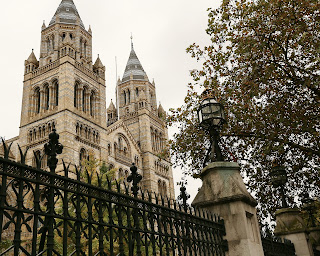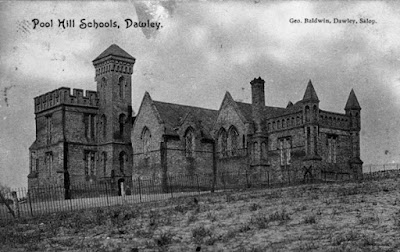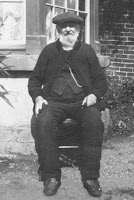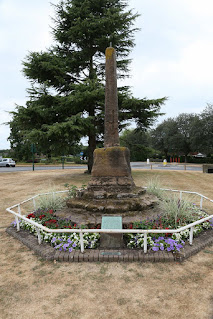Matthew Webb married Madeleine Kate Chaddock (1850) at the Church of St Andrew, West Kensington in 1880.
They had two children:
- Matthew Webb (1881)
- Helen Webb (1882)
1851: Home at High Street, Madeley
1861: On board the
Conway off Cheshire
1871: No record
1881: With his new wife, at 51 Tavistock Crescent, Kensington (now redeveloped). Retired mariner. An architect and a lady from Amsterdam were lodgers, and he kept a servant, Annie Oakley.
That is what the record shows, at first search. But it masks the story of a true A-list celebrity of our tree.
 |
| Matthew Webb - Vanity Fair print (my collection) |
There are family stories about the man, certain that we are related - indeed his closest living relatives - but not sure how (see
Chapter 50.1.1 for the answer to that one). We apparently inherited an important medal and a mysterious 'kissing cup'. It was known that he was born in Dawley, one of the key settlements in our story. Dawley is less than 40 miles, almost due west, from Sutton Coldfield, where the family coalesced. A visit to Dawley reveals an unpretentious market square, with an active market, and a memorial to Webb at its centre. I took some
photos - on purpose this time - it was quite difficult to get close due to beetroot and such! "NOTHING GREAT IS EASY" it says, and headlines his exploits.
 |
| Postcard of the Webb Memorial (my collection) |
So what was the
Conway, and what was the medal?
First, the SS Russia, a Cunard sailing liner, with auxiliary steam power, built in 1867. In 1868, after rounding off a reading tour to America with a trip to Niagara and a big dinner in New York, a relieved and appreciative Charles Dickens returned home onboard the ship. In 1873, a seaman onboard came to public notice for the first time. In an attempt to rescue a 'man overboard', he dived off the ship mid-Atlantic, and remained in the Ocean for 37 minutes. For his bravery, he was awarded the inaugural annual Stanhope Gold Medal by the Royal Humane Society. So that will be the important medal then.
It probably also explains why there is no 1871 census record for him. The 1861 entry refers to the
Conway, a training vessel at Liverpool. He recalls that he had always been fascinated with water, learning to swim in the Severn from the age of eight. He'd always dreamt of going to see. Nevertheless, the
Conway was a shock - a hammock with no sheets instead of his comfortable little bed, and the mixed quality of his contemporaries.
 |
| From the Illustrated London News (my collection) |
After two years on the
Conway, Matthew must have had home leave, during which, in the summer of 1863, he rescued his 12-year-old brother Thomas from drowning in the Severn near Ironbridge. Shortly afterwards, he sailed to Calcutta in the
Cavour, and then to Hong Kong where we had to fight off muggers. Sailing on to Singapore, back to Calcutta and back to England took 17 months. Soon he was off again in the Cavour, visiting Aden and Bombay.
In 1866, he completed his apprenticeship, and qualified as a Second Mate. Later ships were the
Hampden and the
Castleton, in which he visited Japan. He transferred to Brilliant as Second Mate in 1869. It looks like
Brilliant was wrecked on Long Sand in the Thames Estuary in 1872 (I don't know if Webb was onboard - but he doesn't mention it in his resumé!).
While stationed for a while at Port Natal, he was paid £1 a day to make a difficult swim back from the nightly anchorage of a boat being used to recover cargo from a wreck. He qualified as a first mate in 1870, and joined the
Russia on 28 April 1873 as an Able Seaman: the passengers collected
£100 for him after his brave exploit. In January 1875, Matthew joined the
Emerald, as Captain. This may have been the steam coastal cargo ship built in 1889. After six months, and having read about a failed attempt to swim the English Channel in a newspaper, he resigned his commission, and returned home.
He trained in Lambeth pool, close to Westminster Bridge (and the stomping ground of the Larard, Little and Knight families). In July 1875, he set a record by swimming 20 miles from Blackwall to Gravesend.
On 24 August, Webb dived into the water from Admiralty Pier, Dover. Twenty-one hours and 45 minutes later he waded ashore at Calais, after an exhausting zig-zagging swim against the tides and currents of the Channel. "I was terribly exhausted at the time... I can only say that the moment when I touched the Calais sands, and felt the French soil beneath my feet, is one which I will never forget, were I to live for a hundred years." And he thanked the editor of
Land and Water, who had sent him £50 and the pot of porpoise oil, with which he greased himself for the swim. There is a very good account of the swim and Webb's life, including a picture of the
Conway, here.
 |
| From the Illustrated London News (my collection) |
"News of Matthew Webb's amazing feat filtered back to his home community here in Shropshire, he returned in triumph and arriving at Wellington railway station was met by large crowds of locals, eager to share in the glory and heap deserved praise on their own Local Hero. It is known that he was escorted back to Dawley amid a carnival atmosphere boosted by the able ability of the Shifnal Brass Band. [Ed. There were apparently Chinese lanterns all down the Severn by Ironbridge, and the Tontine Hotel was decorated in celebration.] The journey itself was to spawn endless tales of folklore. Arriving as we have into the new Millennium and the year 2000, locals to this day, 125 years on, still refer to The Pig On The Wall. Legend has it that as the Band led Webb's procession into Dawley, a pig placed its front trotters onto the wall of its sty, to watch the band pass by." Shropshire Mining. See also: Dawley Heritage
 |
| Webb's Calling Card (my collection) |
But he wasn't just a local hero. After his record swim, Captain Webb basked in national and international adulation, and followed a career as a professional swimmer.
 |
| Famous 'Pig on the Wall' Postcard (my collection) |
He wrote a book called 'The Art of Swimming' and licensed his name for merchandising such as commemorative pottery.
 |
| The Art of Swimming (my collection) |
A brand of matches was named after him.
 |
| Commemorative Match Boxes (my collection) |
He participated in exhibition swimming matches and stunts such as floating in a tank of water for 128 hours, for which we won £1000. In a quiet wedding, Matthew married the young ("small and refined") Madeleine who seems to have doted on him, and called him 'Mat'. Webb had grown used to the high life and wanted to provide for his new family. He toyed with various schemes, and then came up with the big one.
He wasn't to live for a hundred years. His final stunt, at age was to be a dangerous swim through the Whirlpool Rapids on the Niagara River below Niagara Falls (nearly 100 m high), a feat many observers considered suicidal. Although Webb failed in an attempt at raising interest in funding the event, on 24 July 1883, he jumped into the river from a small boat located near the Niagara Falls Suspension Bridge and began his swim. Accounts of the time indicate that in all likelihood Webb successfully survived the first part of the swim, but died in the section of the river located near the entrance to the whirlpool. He had expected to make a fortune but in the end just wanted to save his name.
 |
| The Scene of Webb's Death (Illustrated London News, my collection) |
Webb was buried in
Oakwood Cemetery, Niagara Falls, New York.
John Betjeman summoned up his ghost in
A Shropshire Lad, performed live
here.
Next (Mary Ann's siblings)




































































